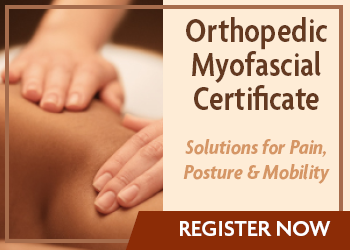Bibliographic Citation: McClure, PW, Flowers, KR. Treatment of Limited Shoulder Motion: A Case Study Based on Biomechanical Considerations. Physical Therapy. 1992(72):929-936
McClure and Flowers presented a case study of a 57 year old woman who sustained a fracture-dislocation of the humeral head (1) They described the patient’s examination, PT interventions used and outcomes to restore range of motion (ROM) in her stiff shoulder. The authors suggested that the standard rationale for manual therapy interventions, known as the concave-convex rule of mobilization, is erroneous. They utilized a variety of clinical reasoning (CR) strategies to explain their findings within this case study.
 The authors used two different styles of diagnostic reasoning: hypothetical-deductive and pattern recognition (2). The authors reasoned that according to a biomechanical perspective, treatment must follow one of two types of problems: a structural or nonstructural model of limitation (one must treat the cause of the limitation) (3). They used a disablement model to explain their approach to treating the limited ROM from a hypothetical-deductive view using data gathered from exam findings to generalize about a specific conclusion (4). They cited references for the concave-convex rule which used mechanical models instead of actual measurements on patients (5). They articulated that: “the distinction between the two types of problems with PROM is important because they involve different treatment strategies” (6). Using the disablement model, the authors collected ROM data from the patient and deduced that there must be a motion restriction in a predictable pattern (capsular pattern). They then tested the hypotheses that a restricted joint will be limited in a certain predictable pattern based on the biomechanical rules known as the concave-convex rule (7). They found that in actual subjects, the concave-convex rule was nullified (8). Most joint mobilizations were based on this rule which did not even apply to actual human subjects (9). “To summarize, we believe treatment decisions should be based on consideration of the structures limiting motion and how to best put tensile stress on these structures rather than restoring a translatory motion that does not really occur during physiologic movement” (10).
The authors used two different styles of diagnostic reasoning: hypothetical-deductive and pattern recognition (2). The authors reasoned that according to a biomechanical perspective, treatment must follow one of two types of problems: a structural or nonstructural model of limitation (one must treat the cause of the limitation) (3). They used a disablement model to explain their approach to treating the limited ROM from a hypothetical-deductive view using data gathered from exam findings to generalize about a specific conclusion (4). They cited references for the concave-convex rule which used mechanical models instead of actual measurements on patients (5). They articulated that: “the distinction between the two types of problems with PROM is important because they involve different treatment strategies” (6). Using the disablement model, the authors collected ROM data from the patient and deduced that there must be a motion restriction in a predictable pattern (capsular pattern). They then tested the hypotheses that a restricted joint will be limited in a certain predictable pattern based on the biomechanical rules known as the concave-convex rule (7). They found that in actual subjects, the concave-convex rule was nullified (8). Most joint mobilizations were based on this rule which did not even apply to actual human subjects (9). “To summarize, we believe treatment decisions should be based on consideration of the structures limiting motion and how to best put tensile stress on these structures rather than restoring a translatory motion that does not really occur during physiologic movement” (10).
The authors appeared to use the Hypothesis Oriented Algorithm for Clinicians (HOAC) model of clinical reasoning (CR) to organize the patient data, and test their hypotheses prior to developing a plan of care (11). They used research evidence to question their hypotheses and to alter their approach to treatment. They used task analysis evidence from the literature to show that the concept of component motion is mistaken. They then altered their treatment decisions based on the new evidence. It does not appear they used an enablement model, since they did not present much information from the personal perspective of the patient. They only mentioned she was the wife of a physician, who wanted to restore mobility for ADL, and not for any athletic activities. They could have included more info on the patient’s perceived needs, her resources and abilities (12). The authors analyzed the patient’s performance of specific tasks using her stiff shoulder (13). Although they reported the patient’s complaint, they did not reveal anything much to contribute to understanding the patient’s view of the problem, other than limited motion resulting in limited ADL (14).
McClure and Flowers discussed how pattern recognition did not make sense in light of the standard knowledge of the biomechanical rules of joint motion. It was previously thought that joints possess component motions known as roll, spin, and glide. These component motions were said to occur in predictable patterns in normal joints. In people with motion restrictions, the lack of these component motions was deemed responsible for the impairment. The rationale was therefore that treatment using the component motion will remedy the limitation. When researched on human subjects, this was not the case (15). Pattern recognition would have lead the clinicians to reason “from a set of specific observations toward a generalization, and is known as forward reasoning. Forward reasoning contrasts with hypothetical deductive reasoning where a person moves from a generalization (multiple hypotheses) toward a specific conclusion” (16). Although the pattern recognition is a more efficient mode of CR, in the case of the concave-convex rule, the rationale was based on erroneous research. The authors were astute to reconsider their approach using new research performed on human subjects, instead of mechanical models (17). The authors concluded that “Many of our treatment decisions were based primarily on clinical experience rather than direct scientific data” (18). They came to a generalization about therapy interventions based on actual objective measurements of motion rather than questionable theories and limited evidence. McClure used forward reasoning to come to the specific conclusion that “treatment decisions should be based on consideration of the structures limiting motion and how to best put tensile stress on theses structures rather than restoring translatory motion that does not really occur during physiologic movement” (19).
Other strategies that could have been used to analyze the case from a different viewpoint are the HOAC and the dialectical models of CR. The authors then tested their hypothesis that other structures could be implicated other than the joint capsules stretched during joint mobilization. In the HOAC model, hypotheses are tested repeatedly, allowing the PT to reassess patient management and make changes where needed. Using the HOAC, the authors could have included information about the patient’s resources, environment and abilities to contribute to the resolution of her problem. It appeared this was not a consideration in the deductive model they used. The dialectical model encompasses the most comprehensive aspects of CR, including “those cognitive decision-making processes required to optimally diagnose and manage patient presentations of physical disability and pain (hypothetical-deductive or instrumental reasoning and action) and those required to understand and engage with patients’ (or caregivers’) experience of that disability and pain (narrative or communicative reasoning and action) (20). The dialectical model emcompasses both aspects of the traditional medical model with hypotheses testing and the patient-oriented model of communicative reasoning (21). It is a more comprehensive approach to examination and management.
It appears that the traditional biomechanical models we based most of our manual therapy decisions on are questionable at best. Clinicians must not simply accept what the literature says about why manual therapy interventions work. Often, these conclusions are based on limited or faulty data or statistical methods. We relied on studies that were not done on real people, but rather on models (22). For clinical research to assist us in development of appropriate treatment interventions, we must reflect upon studies which most closely approximate real life situations, not simply models. For a comprehensive approach, we must consider both the deductive and communicative reasoning methods to develop a Wholistic view of a patient’s problem. Patients’ perspectives must be included in the planning and development of their program to generate successful outcomes. It is critical to utilize a variety of CR strategies to achieve maximum benefit to our patients and to our profession.

